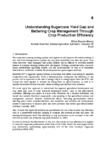Use este identificador para citar ou linkar para este item:
http://www.alice.cnptia.embrapa.br/alice/handle/doc/924313Registro completo de metadados
| Campo DC | Valor | Idioma |
|---|---|---|
| dc.contributor.author | MARIN, F. R. | pt_BR |
| dc.date.accessioned | 2012-05-10T11:11:11Z | pt_BR |
| dc.date.accessioned | 2012-05-10T11:11:11Z | pt_BR |
| dc.date.available | 2012-05-10T11:11:11Z | pt_BR |
| dc.date.available | 2012-05-10T11:11:11Z | pt_BR |
| dc.date.created | 2012-05-10 | pt_BR |
| dc.date.issued | 2012 | pt_BR |
| dc.identifier.citation | MARIN, F. R. (Ed.). Crop management - cases and tools for higher yield and sustainability. Rijeka: InTech, 2012. cap. 6, p. 109-118. | pt_BR |
| dc.identifier.uri | http://www.alice.cnptia.embrapa.br/alice/handle/doc/924313 | pt_BR |
| dc.description | The comparison among farming systems and regions would improve the understanding of how and what driving factors explains the crop yield variability over time and space. Very often, however, farm managers and policy makers fall in difficult to establish reliable indexes to compare farming systems plots and regions. Having a quantitate index, we could derive relationships regarding climate, soil and socioeconomic, as well as to determine which factors contribute or hinder the development in a given region and time. Monteith (1977) suggested agroecosystems as machines that utilize solar energy to maintain composition and organization. From a thermodynamic standpoint, the efficiency of any process can be expressed as the ratio of energy output to energy input. Since the 1970s, this concept has been applied to analyze the energy flow in agroecosystems, as well as to analyze the relation between biomass chemical energy and incident solar radiation. We could apply this approach to understand the regional agricultural development and crop yield gap, once it could elucidate biophysical factors, such as the pedoclimatic conditions, affecting crop yields at a local scale. However, for a broader evaluation, one should also include structural components, corresponding to the agricultural systems and management practices adopted; institutional effects, involving governmental actions affecting price, credit, commercialization, and incentives; and research and development, related to innovations to increase yield and solve problems that restrict agricultural-related activities (Carvalho, 2009). Also, to make this approach useful in an operational way, one could assume crop efficiency such as a quantitative indicator, helping to compare and evaluate in time and space, the farming development level. The efficiency of crop production can be assumed as the ratio between observed and attainable crop yield (Marin et al., 2008). In order to evaluate the effectiveness of this tool, the concept of crop efficiency was applied to study the sugarcane performance in the State of São Paulo, Brazil, the main region of this crop production, representing approximately 60% of the total Country's sugarcane production (IBGE, 2002). | pt_BR |
| dc.language.iso | eng | eng |
| dc.rights | openAccess | eng |
| dc.subject | Manejo de cultivos | pt_BR |
| dc.subject | Produção de cultivos | pt_BR |
| dc.title | Understanding sugarcane yield gap and bettering crop management through crop production efficiency. | pt_BR |
| dc.type | Parte de livro | pt_BR |
| dc.date.updated | 2018-03-08T11:11:11Z | pt_BR |
| dc.subject.thesagro | Cana de açúcar | pt_BR |
| dc.subject.nalthesaurus | Crop management | pt_BR |
| dc.subject.nalthesaurus | Crop production | pt_BR |
| dc.subject.nalthesaurus | Sugarcane | pt_BR |
| riaa.ainfo.id | 924313 | pt_BR |
| riaa.ainfo.lastupdate | 2018-03-08 -03:00:00 | pt_BR |
| dc.contributor.institution | FÁBIO RICARDO MARIN, CNPTIA. | pt_BR |
| Aparece nas coleções: | Capítulo em livro científico (CNPTIA)  | |
Arquivos associados a este item:
| Arquivo | Descrição | Tamanho | Formato | |
|---|---|---|---|---|
| 6.pdf | 874,68 kB | Adobe PDF |  Visualizar/Abrir |









